Are you a book-lover? I’ve been one all my life, although my home library has had to be pared down to only 281 (as of today; I have a few more on pre-publication order) due to limited space, and I’ve no desire to join the digital-book brigade. For several reasons, e-books simply aren’t for me. If you, too, are a bibliophile, you might enjoy this quick ‘book tour’ of Cybis porcelains that included a book as a design element.
But first, I want to explain the criteria that I used when determining which were the bookish Cybis. The Oxford English Dictionary defines a book as
(1) a written or printed work consisting of pages glued or sewn together along one side and bound in covers.
(2) a bound set of blank sheets for writing or keeping records in.
These definitions – with which I’m in complete agreement – eliminate three Cybis sculptures: Portia who carries a rolled-up scroll with a seal on it, Mister President because he is holding a single sheet of parchment, and Moses who holds a stone tablet.
However, there were at least 17 Cybis items that did indeed incorporate a book, starting with three religious pieces from the 1950s which Cybis cast from commercially-purchased molds.
 Saint Patrick holds a Bible in his left hand. Chronologically this is possible, because Patrick lived during the early 400s.
Saint Patrick holds a Bible in his left hand. Chronologically this is possible, because Patrick lived during the early 400s.
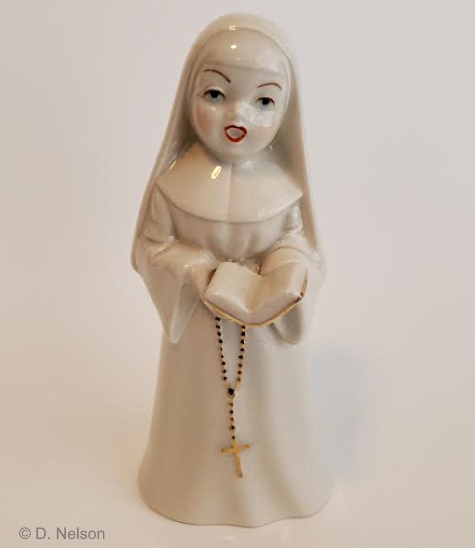 The singing nun holds a songbook. She is about 5” tall and is a companion piece to a Holland Mold praying nun that was also produced by Cybis during that decade.
The singing nun holds a songbook. She is about 5” tall and is a companion piece to a Holland Mold praying nun that was also produced by Cybis during that decade.

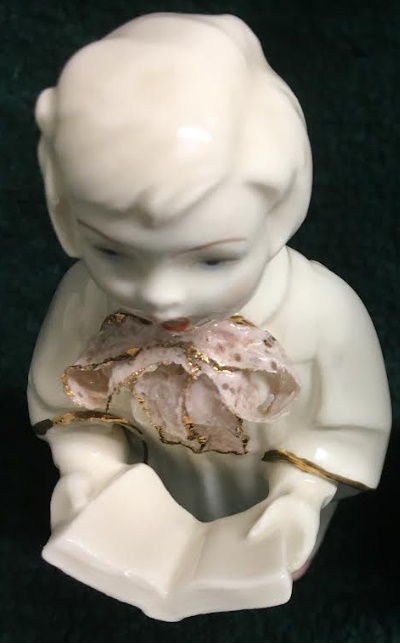 The choir girl was part of a 1950s Holland Mold set of six singing children but only two of them (a boy and a girl) hold a songbook. As the second photo illustrates, the book in these 1950s items was simply part of the mold, rather than being a separate piece as is the case with all of the original Cybis Studio designs.
The choir girl was part of a 1950s Holland Mold set of six singing children but only two of them (a boy and a girl) hold a songbook. As the second photo illustrates, the book in these 1950s items was simply part of the mold, rather than being a separate piece as is the case with all of the original Cybis Studio designs.
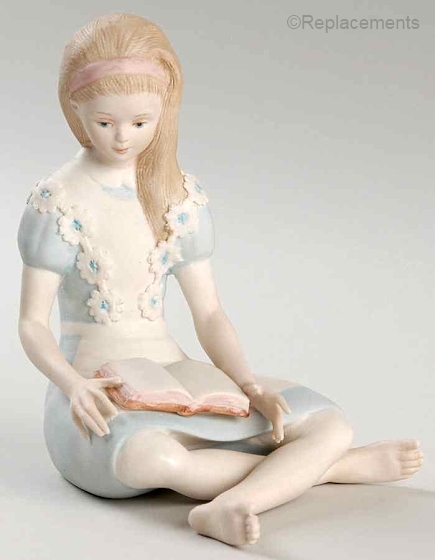 Alice in Wonderland is the earliest original Cybis piece to include a book. She was introduced in 1964 as an open edition in color and in white bisque (which I have never seen.) The white one was made for only one year, and the color version was retired in 1969.
Alice in Wonderland is the earliest original Cybis piece to include a book. She was introduced in 1964 as an open edition in color and in white bisque (which I have never seen.) The white one was made for only one year, and the color version was retired in 1969.
 This detached book shows that the mold has a rather large firing hole. Porcelain ‘slip’ originally attached the book to Alice’s lap.
This detached book shows that the mold has a rather large firing hole. Porcelain ‘slip’ originally attached the book to Alice’s lap.
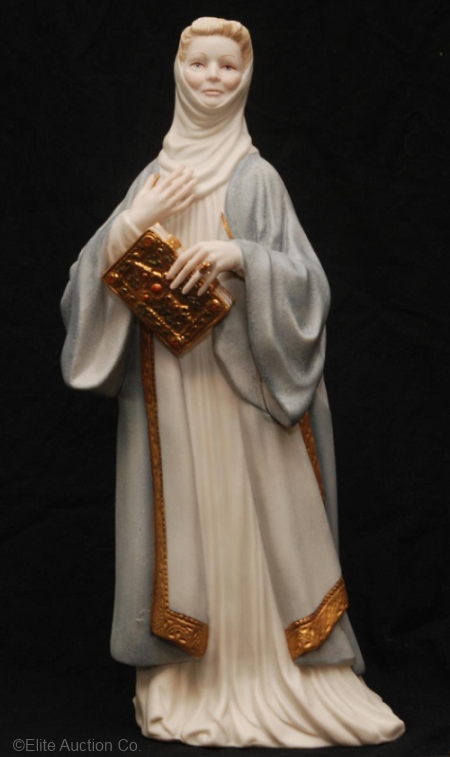
 Eleanor of Aquitaine, sculpted by Patricia Eakin, holds an elaborately-decorated book. The real Eleanor would have owned similar books because, as heir to her father’s dukedom which covered 1/3 of France, she was well educated and could read and write in French and in Latin. Later, as Queen of France and then Queen of England, she patronized philosophers and poets. The Cybis Eleanor was issued in 1971 and completed in 1975.
Eleanor of Aquitaine, sculpted by Patricia Eakin, holds an elaborately-decorated book. The real Eleanor would have owned similar books because, as heir to her father’s dukedom which covered 1/3 of France, she was well educated and could read and write in French and in Latin. Later, as Queen of France and then Queen of England, she patronized philosophers and poets. The Cybis Eleanor was issued in 1971 and completed in 1975.
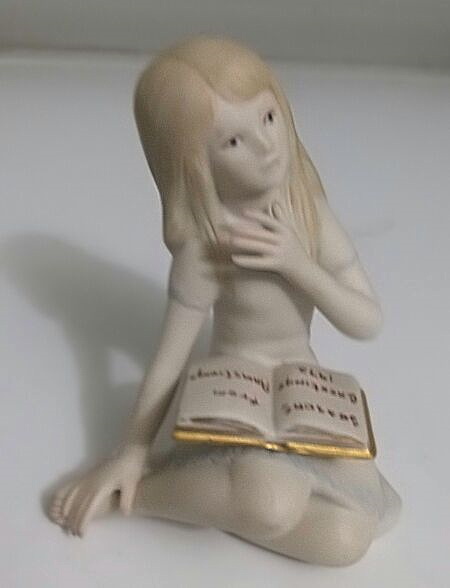 The normal retail Thumbelina (1957-1972) never had a book, but in 1972 one of the studio’s largest retailers – Armstrong’s Gallery – requested a special run of this piece for them to give to their best customers as a holiday gift.
The normal retail Thumbelina (1957-1972) never had a book, but in 1972 one of the studio’s largest retailers – Armstrong’s Gallery – requested a special run of this piece for them to give to their best customers as a holiday gift.
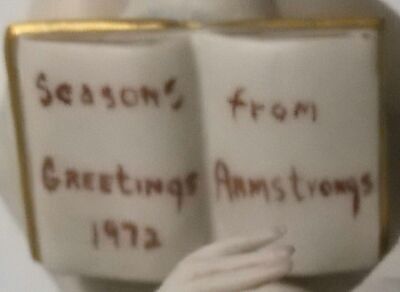 The pages say, in gold paint, Season’s Greetings 1972 from Armstrongs. The book mold is the same one that the studio had used for Alice in Wonderland during the 1960s.
The pages say, in gold paint, Season’s Greetings 1972 from Armstrongs. The book mold is the same one that the studio had used for Alice in Wonderland during the 1960s.

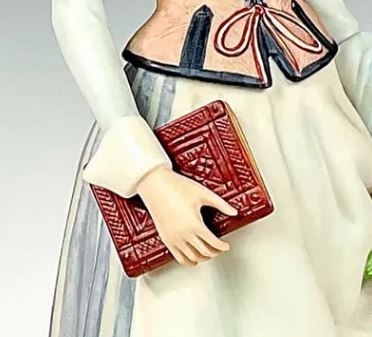 Priscilla, designed by Dolores Valenza, was a limited edition in 1976. She carries a book, but it is now known that Mrs. Valenza’s original model was different in significant ways from the final retail piece shown here. Did the original sculpture include a book? We will never know, but because the production model does, she is included here!
Priscilla, designed by Dolores Valenza, was a limited edition in 1976. She carries a book, but it is now known that Mrs. Valenza’s original model was different in significant ways from the final retail piece shown here. Did the original sculpture include a book? We will never know, but because the production model does, she is included here!
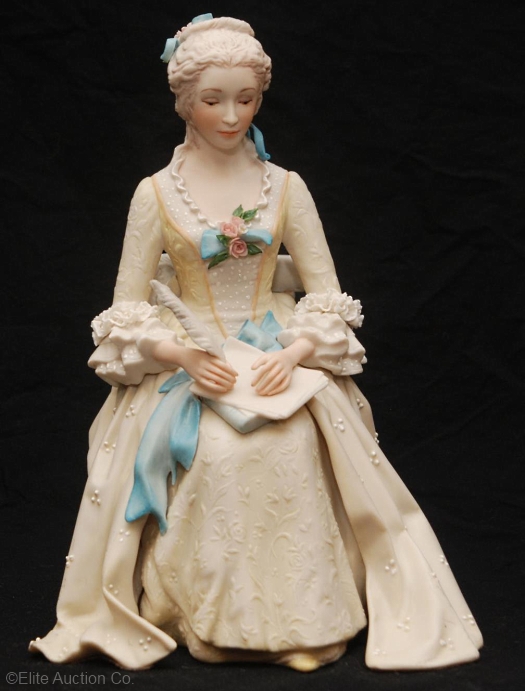
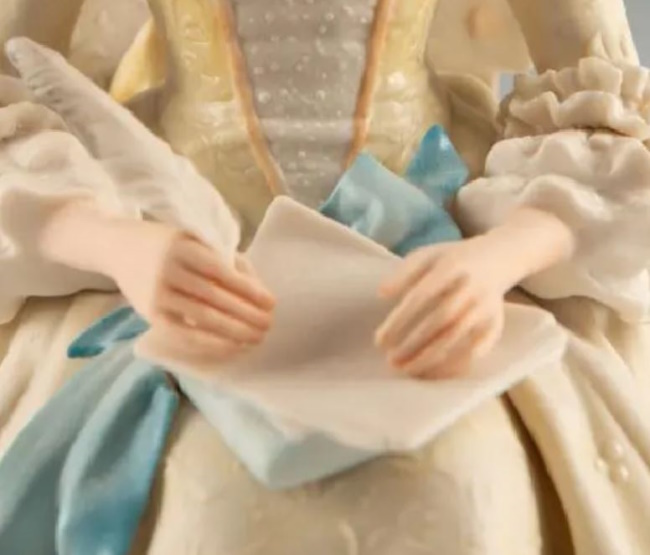 I originally thought that Abigail Adams is only holding sheets of parchment, but a sharp-eyed friend pointed out that she has a closed book in her lap to serve as an impromptu writing desk! It is easily missed because the spine is a paler shade of the same blue used on her skirt’s large ribbon bow next to it. This is another case where the designer’s original model was changed by the studio before production. Lynn Klockner Brown created this piece as a portrait of Betsy Ross, holding a needle instead of a quill pen, and a flag instead of a book and parchment paper. But this ultimately reached the retail stores as Abigail rather than Betsy. Her 1976 edition of 600 was completed in 1981.
I originally thought that Abigail Adams is only holding sheets of parchment, but a sharp-eyed friend pointed out that she has a closed book in her lap to serve as an impromptu writing desk! It is easily missed because the spine is a paler shade of the same blue used on her skirt’s large ribbon bow next to it. This is another case where the designer’s original model was changed by the studio before production. Lynn Klockner Brown created this piece as a portrait of Betsy Ross, holding a needle instead of a quill pen, and a flag instead of a book and parchment paper. But this ultimately reached the retail stores as Abigail rather than Betsy. Her 1976 edition of 600 was completed in 1981.
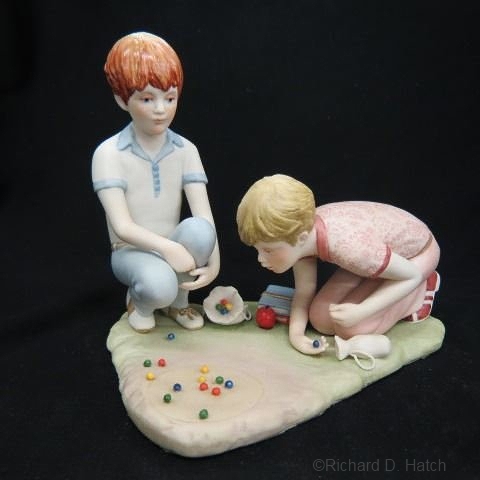
 There are two schoolbooks (and an apple for the teacher) as a design element in Rusty and Jonny (Playing Marbles), an open edition in 1977.
There are two schoolbooks (and an apple for the teacher) as a design element in Rusty and Jonny (Playing Marbles), an open edition in 1977.
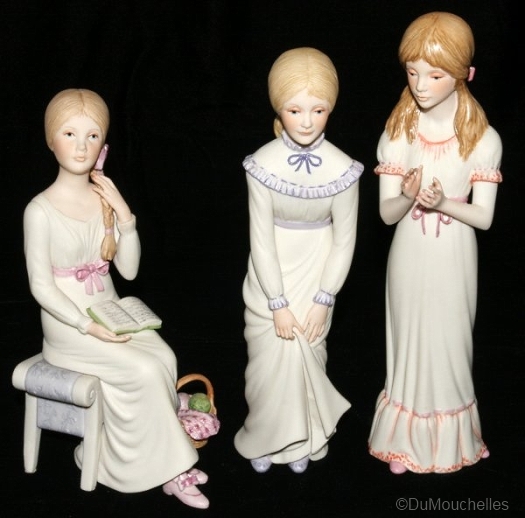
 The studio issued three separate ‘companion’ pieces as The Children’s Hour group in 1978, all of them open editions. Alice, described as “grave Alice” in Longfellow’s poem, here looks up from her reading.
The studio issued three separate ‘companion’ pieces as The Children’s Hour group in 1978, all of them open editions. Alice, described as “grave Alice” in Longfellow’s poem, here looks up from her reading.
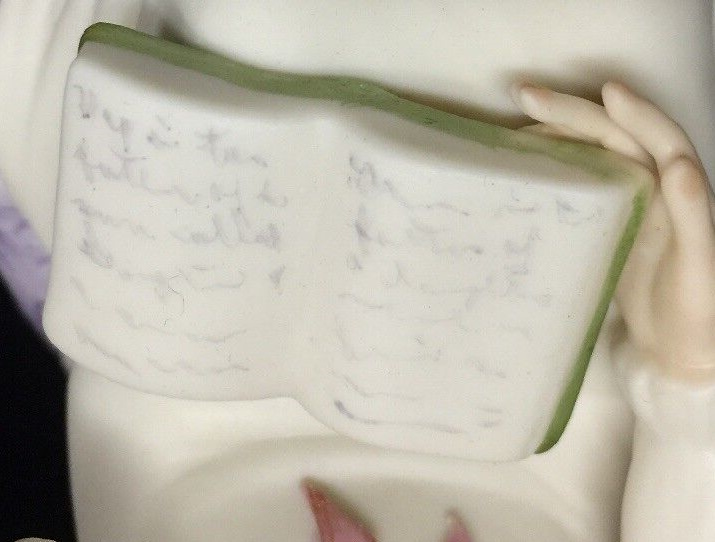 Alice’s book has some hand-painted ‘writing’ instead of blank pages but, depending on which Cybis artist was doing the decorating, there may or may not be actual words. For example, the left-hand page of this book has a few decipherable words – one of which appears to be called – but the rest of it is just squiggles.
Alice’s book has some hand-painted ‘writing’ instead of blank pages but, depending on which Cybis artist was doing the decorating, there may or may not be actual words. For example, the left-hand page of this book has a few decipherable words – one of which appears to be called – but the rest of it is just squiggles.
 Here are two more examples. The book on the left has actual words alternating with tildes and almost-straight lines. The words on the first page are “Once there”, “today”, “nice but”, “he was” and “at”; on the second page they are “Happy”, “on”, “table”, either “took” or “look”, “her” , “yes”, and “Cybis”. However, the other book’s pages don’t appear to have any actual words on them.
Here are two more examples. The book on the left has actual words alternating with tildes and almost-straight lines. The words on the first page are “Once there”, “today”, “nice but”, “he was” and “at”; on the second page they are “Happy”, “on”, “table”, either “took” or “look”, “her” , “yes”, and “Cybis”. However, the other book’s pages don’t appear to have any actual words on them.

 Little Miss America, created by William Pae, cradles a book in her left arm. She was offered as an open edition in 1986 only. In 1991 the studio resurrected her under a slightly different name (Little Miss Liberty) and sold her online for a short time. During the 2000s, they brought her back as Little Miss Liberty with Bow; the ‘bow’ was a yellow ribbon which replaced the book in her hand. The original sculptures sold in 1986 and in the early 1990s include the book, but the circa-2000s pieces (if any) do not.
Little Miss America, created by William Pae, cradles a book in her left arm. She was offered as an open edition in 1986 only. In 1991 the studio resurrected her under a slightly different name (Little Miss Liberty) and sold her online for a short time. During the 2000s, they brought her back as Little Miss Liberty with Bow; the ‘bow’ was a yellow ribbon which replaced the book in her hand. The original sculptures sold in 1986 and in the early 1990s include the book, but the circa-2000s pieces (if any) do not.
 The actual Statue of Liberty does not hold a book; it is a tablet, with the date July 4 1776 in Roman numerals. The Cybis piece has no writing or title on the book’s cover.
The actual Statue of Liberty does not hold a book; it is a tablet, with the date July 4 1776 in Roman numerals. The Cybis piece has no writing or title on the book’s cover.
 The 1984 Choir Boy was created to honor the American Boychoir School which received a portion of the sales profit from it. He is 8.5” and was an open edition that was retired in 1988 but the studio brought him back as an available piece on their early-2000s website.
The 1984 Choir Boy was created to honor the American Boychoir School which received a portion of the sales profit from it. He is 8.5” and was an open edition that was retired in 1988 but the studio brought him back as an available piece on their early-2000s website.
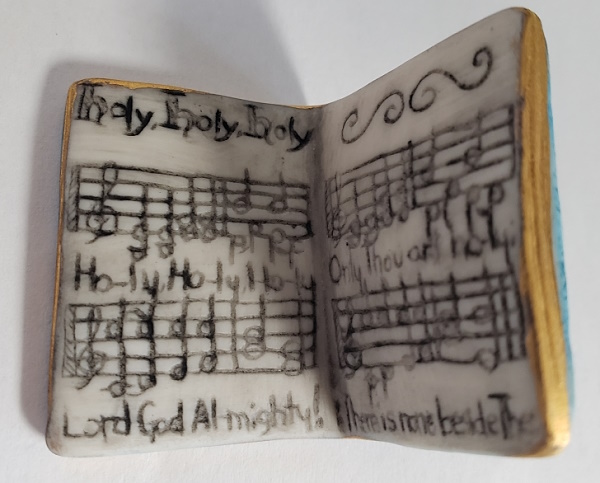
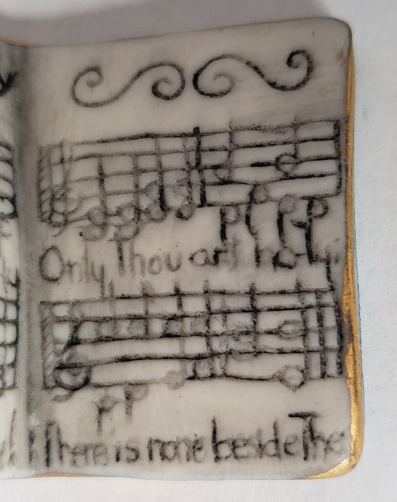 The pages of the book contain music and some lyrics from the hymn Holy Holy Holy. The sheet music does not match that of the actual hymn, though (yes, I checked; I am that much of a nerd.) The words and music are mold impressions which are highlighted with a ‘brush-over’ of black paint.
The pages of the book contain music and some lyrics from the hymn Holy Holy Holy. The sheet music does not match that of the actual hymn, though (yes, I checked; I am that much of a nerd.) The words and music are mold impressions which are highlighted with a ‘brush-over’ of black paint.
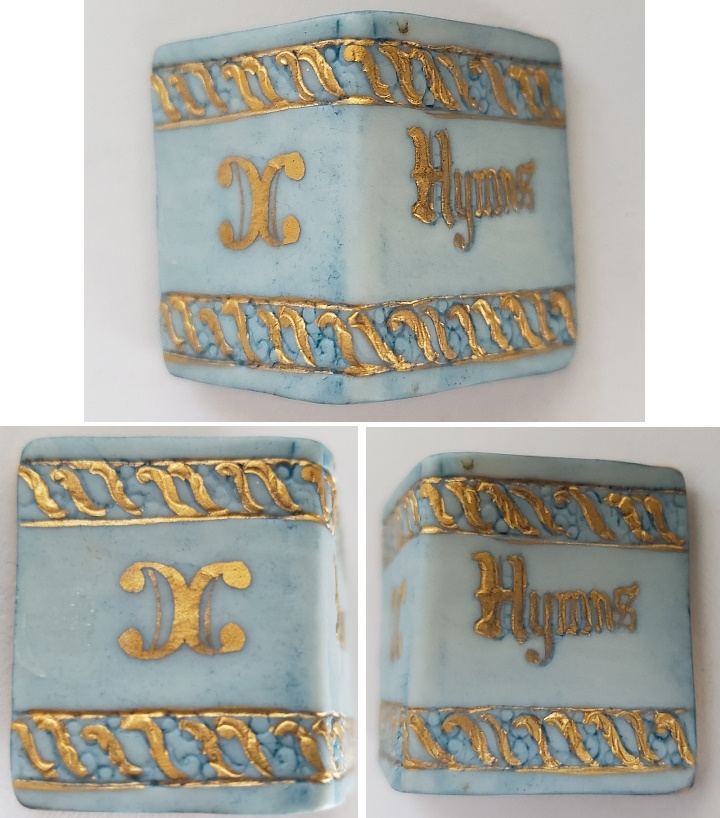 With the book in place, most of the front and back covers are obscured by the boy’s hands. This detached book reveals the full design of that side and how the 24-kt gold paint accents were applied. The hand-painted design on the back cover is an ‘Easter egg’ for knowledgeable Cybis collectors: It is the back-to-back double-C monogram that the studio used during the 1940s! I had no idea that it was there until I saw this photo of a detached book.
With the book in place, most of the front and back covers are obscured by the boy’s hands. This detached book reveals the full design of that side and how the 24-kt gold paint accents were applied. The hand-painted design on the back cover is an ‘Easter egg’ for knowledgeable Cybis collectors: It is the back-to-back double-C monogram that the studio used during the 1940s! I had no idea that it was there until I saw this photo of a detached book.
 Mick the Melodious Mutt, one of the series of Musical Menagerie animals, holds a songbook. Designed by Susan Clark Eaton, he appeared as an open edition in 1986 and is about 6.5” high.
Mick the Melodious Mutt, one of the series of Musical Menagerie animals, holds a songbook. Designed by Susan Clark Eaton, he appeared as an open edition in 1986 and is about 6.5” high.
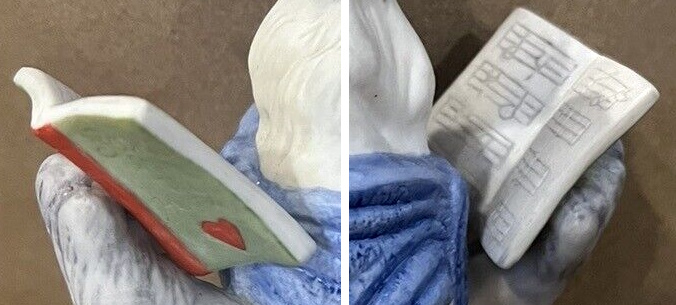 The songbook has an impressed title (Songs From the Heart) and heart motif, and impressed musical notes which (as was done with the Choir Boy’s book) are lightly brushed over with paint.
The songbook has an impressed title (Songs From the Heart) and heart motif, and impressed musical notes which (as was done with the Choir Boy’s book) are lightly brushed over with paint.
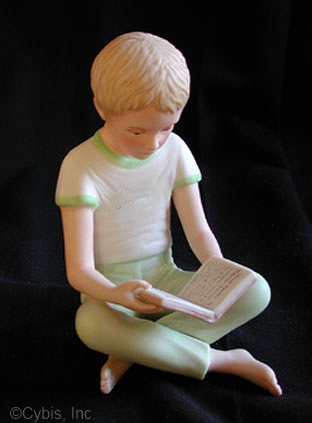 This late-1980s piece is on an early 1990s price list as Andy (Boy with Book) which is rather obvious, I would think! He is 4.75” high. He is 4.75” high. Like Alice Longfellow’s book, these seem to have a combination of lines, squiggles, and actual words.
This late-1980s piece is on an early 1990s price list as Andy (Boy with Book) which is rather obvious, I would think! He is 4.75” high. He is 4.75” high. Like Alice Longfellow’s book, these seem to have a combination of lines, squiggles, and actual words.
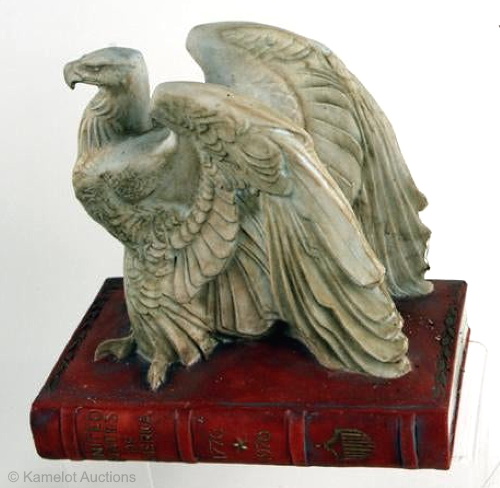
 Three examples of this unreleased Bicentennial eagle were included in the studio’s liquidation sale lots in 2019 and 2020.
Three examples of this unreleased Bicentennial eagle were included in the studio’s liquidation sale lots in 2019 and 2020.
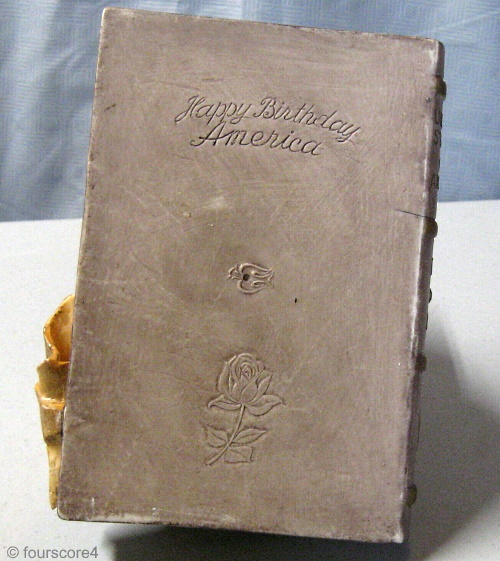
The 1776-1976 on the spine and the Happy Birthday America on the underside indicate that this was a Bicentennial design candidate that didn’t make the retail cut. The rose is the national flower of the USA, although it didn’t become official until President Reagan signed a proclamation making it so in October 1986.
 Here’s a size comparison of two Cybis book molds, two decades apart. I am not sure whether the Choir Boy’s book mold was re-used for Andy, but the angles do seem the same. Because Andy is half the size of the Choir Boy, perhaps the earlier book mold was downsized for him.
Here’s a size comparison of two Cybis book molds, two decades apart. I am not sure whether the Choir Boy’s book mold was re-used for Andy, but the angles do seem the same. Because Andy is half the size of the Choir Boy, perhaps the earlier book mold was downsized for him.
Two More (maybe three) 1950s Cybis ‘Book’ Items
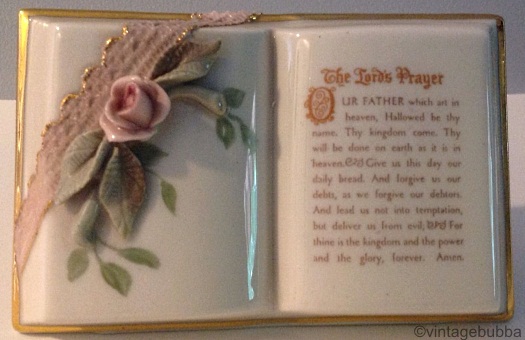
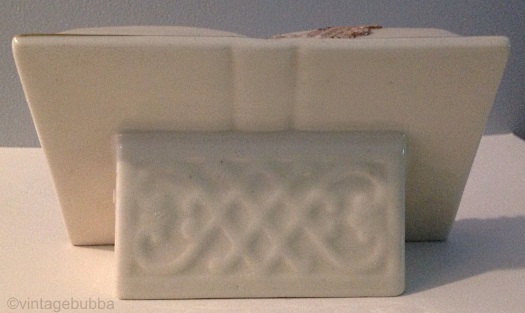 This Lord’s Prayer book has been found in two formats: as a plaque, and as a vase. Either way, it was cast from a Holland Mold Company mold. This is the plaque version, which has a separate wedge-shaped back; it is 5.75” wide and only 3” high. The prayer itself was applied as a decal; I am told that this is the Protestant version. The design number for this item was 242P.
This Lord’s Prayer book has been found in two formats: as a plaque, and as a vase. Either way, it was cast from a Holland Mold Company mold. This is the plaque version, which has a separate wedge-shaped back; it is 5.75” wide and only 3” high. The prayer itself was applied as a decal; I am told that this is the Protestant version. The design number for this item was 242P.
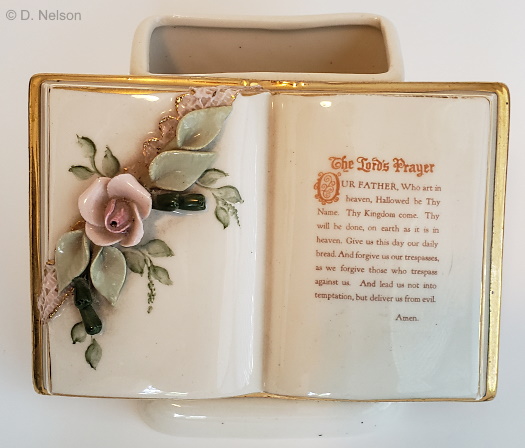
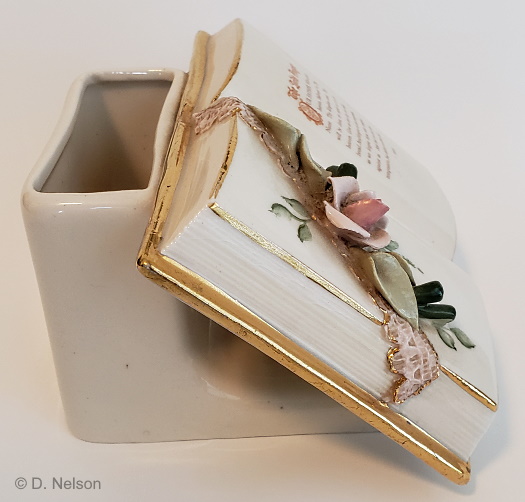 Here is the same book but as a Lord’s Prayer book vase instead. It is deeper front-to-back because of the vase component. This is the Catholic version of the prayer decal; the design number of this is 242. Cybis also produced a free-standing Hail Mary Plaque but that is in the shape of a scroll rather than a book.
Here is the same book but as a Lord’s Prayer book vase instead. It is deeper front-to-back because of the vase component. This is the Catholic version of the prayer decal; the design number of this is 242. Cybis also produced a free-standing Hail Mary Plaque but that is in the shape of a scroll rather than a book.

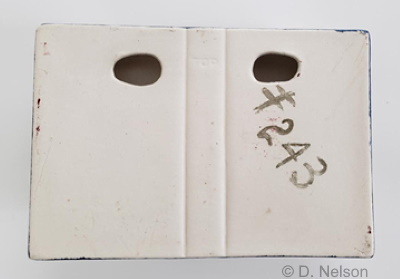 This madonna-and-child bas-relief is part of a book-shaped plaque. This was probably a Holland Mold design as well. It is 5.5” wide and 4.5” high; the #243 on the back is the Cybis design number. Initially, I thought this was meant to hang on a wall – which it certainly could – but the two holes are rather large! So I’m wondering if this may have been one of two molds, the other (which would have been attached to back via the holes) being a vase or wedge back, such as in the Lord’s Prayer examples.
This madonna-and-child bas-relief is part of a book-shaped plaque. This was probably a Holland Mold design as well. It is 5.5” wide and 4.5” high; the #243 on the back is the Cybis design number. Initially, I thought this was meant to hang on a wall – which it certainly could – but the two holes are rather large! So I’m wondering if this may have been one of two molds, the other (which would have been attached to back via the holes) being a vase or wedge back, such as in the Lord’s Prayer examples.
I have no photo of the other possible third circa-1950s ‘book-related’ Cybis, which is Saint Anne with Mary. We don’t know what the Cybis piece looks like, but if you google saint anne and mary you will see that many portraits and figurines show them reading together from a book (most often) or a scroll (less often.) Saint Anne is identified as the mother of Mary in both Christian and Islamic belief. Why the book? According to the University of Rochester’s department of Medieval Studies, Saint Anne was traditionally associated with
prosperity, diligence, generosity to the poor, married chastity, and harmonious family life, and (since she was often portrayed with a book, teaching the young Virgin Mary to read) with education, especially for women.
Of course, there were no such things as bound books in those days. The closest approximation would have been the libelli (a piece of parchment folded over several times, similar to a gatefold pamphlet today) which appeared in the late first century (80-90 A.D.) in Rome. The first true bound books (codex) did not appear until the middle of the second century A.D., so the most accurate depiction of Saint Anne with Mary should include a scroll rather than a book. But until a Cybis Saint Anne with Mary turns up online, we won’t know whether it should be included here!
My favorite quote about books (author unknown):
If you have a garden and a library, you have everything you need.
Name Index of Cybis Sculptures
Visual Index (for human figures/busts only)
About the Cybis Reference Archive
What is Cybis?
Images of Cybis porcelains are provided for informational and educational purposes only. All photographs are copyrighted by their owner as indicated via watermark and are used here only as reference material. Please see the Copyright Notice in the footer and sidebar for important information regarding the text that appears within this website.
The Cybis Archive is a continually-updated website that provides the most comprehensive range of information about Cybis within a single source. It is not and never has been part of the Cybis Porcelain studio, which is no longer in business.